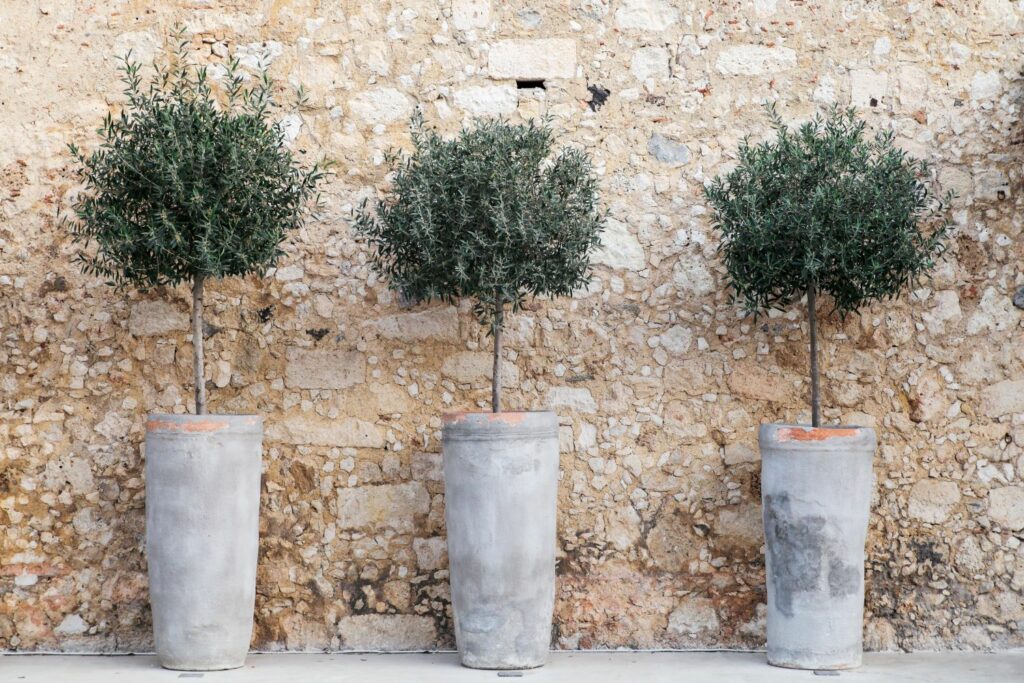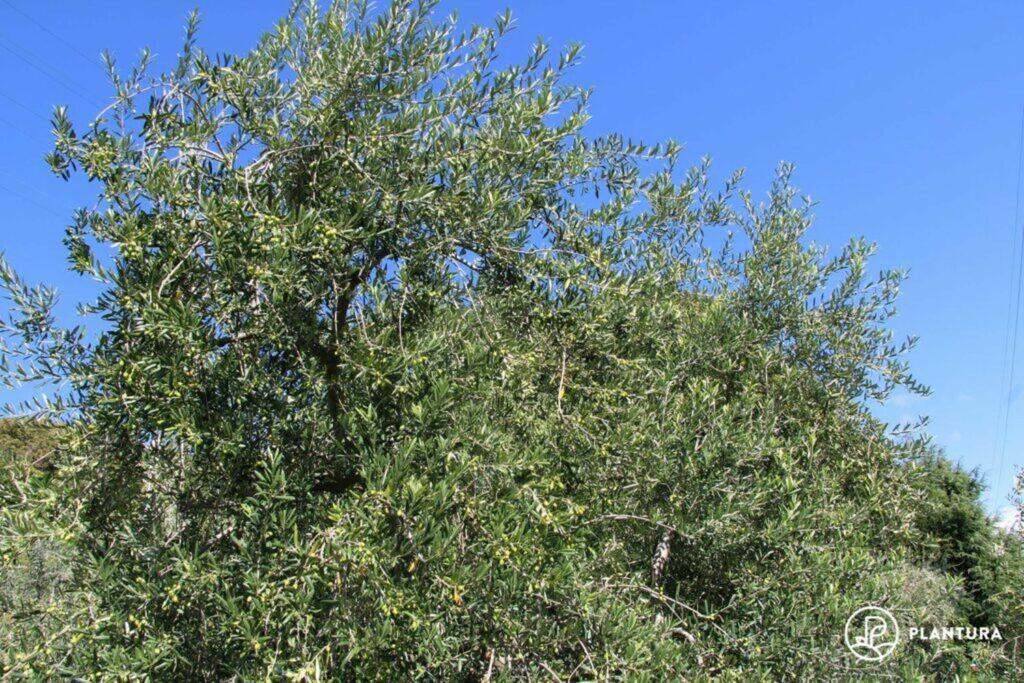Potted olive trees add a touch of Mediterranean flair to your garden. This article explains how to care for olive trees in pots and what to keep in mind for overwintering.

Olive trees(Olea europea) feel at home in the warm, dry climate of the Mediterranean. That said, olives are so robust that they can thrive in other environments too, provided they are protected from cold and wet winters. For this reason, cultivating your olive tree in a pot is the perfect way to make winter care easier. Furthermore, as a slow-growing woody plant, a potted olive tree is just the thing for those who fancy a low-maintenance, long-term addition to their garden.
You are watching: Olive trees in pots: planting, pruning & fertilising potted olive trees
Where to keep a potted olive tree
Most people think of potted plants as pretty little houseplants. But an olive tree is happiest outdoors and enjoys fresh air for as long as possible throughout the year. Olives do not grow well indoors and will quickly shed their leaves without enough sunlight. Therefore, when the weather warms up in summer, it is time to get them outside. Choose the location carefully, as this will have a big impact on the well-being of your olive tree. Whether in the garden or on your balcony or terrace, make sure to place your olive tree in a not-too-draughty, sunny spot. Also, remember to turn the pot regularly so that all branches get plenty of sun. The olive tree needs protection in winter, but it should not be kept in a warm house as some exposure to cold is important for the normal development of the tree. The type of soil used for a potted olive tree is also important for healthy development. Potted olive trees need a permeable, well-structured soil.

Potted olive tree care
It is important to take good care of olive trees, especially those in containers. Otherwise, pests and diseases can quickly take hold. However, if you follow these care steps, your olive tree will bring you joy for many years to come.
- Watering: Water occasionally, allowing the soil surface to dry out in between; avoid waterlogging.
- Fertilising: Start fertilising in the second year, March to August, every two weeks apply liquid fertiliser when watering; use long-lasting granular fertiliser when repotting.
- Soil: Well-structured and permeable; garden soil mixed with potting soil, clay granules and sand.
- Repotting: Repot regularly – young plants roughly every two years, older plants roughly every five years. If your tree becomes too large to repot, the choice of growing medium and good fertilisation is all the more important.
- Pruning: In spring, as described below.

To avoid waterlogging and root rot, only use pots with a drainage hole. In addition, lay a layer of gravel or clay shards at the bottom of the pot to ensure water can drain off easily. For optimal water drainage, place the pot on a stand, not directly on the ground or on a trivet.
A liquid fertiliser, such as our Plantura Liquid Citrus Food, is ideal for feeding olive trees in pots. It supplies the olive plant with essential nutrients and increases its resistance to drought, pests and frost while also supporting healthy root growth. For more info, check out our article on fertilising olive trees.
Pruning potted olive trees
Read more : How To Stop Bugs From Eating Your Vegetables
Olive trees can be pruned as trees or shrubs. Younger plants grow sparsely by nature and should therefore be pruned more frequently. Pruning a young olive tree encourages the plant to branch out more and form a crown or dense shrub.
Once your olive tree has achieved the desired shape, further pruning is only needed for maintenance. Shorten any shoots that are too long to a side shoot or to their origin on a stronger branch – avoid leaving stumps. Also, if two branches cross, remove the weaker one. This is especially important for the inside of a crown or shrub; olive trees should not be allowed to grow too densely.
Note: You can prune back old healthy olive trees heavily to encourage new, rejuvenated growth.
Light pruning can be done any time of year. With that in mind, save more radical pruning for springtime. After your tree has rested through winter, it will have lots of energy to develop vigorous new shoots. Find out more in our article on how to prune your olive tree.
Repotting olive trees
Olive trees in pots take a long time to grow, especially if they are not repotted regularly. So, if you want your olive tree to grow quickly, repot it once a year in the beginning. Later, repot every 2 to 3 years into high-quality soil. Thereafter, you will know it is time to repot when you see the tree roots growing out of the bottom of the planter. For more information on this topic, read our article on how to repot your olive tree.
However, one thing should be clear: if you skimp on the soil, your olive tree will be more susceptible to pests, illnesses, and growth depression. The best soil for olive trees in pots is textured, not overly nutrient-rich, and well-draining. Olive trees prefer a pH between 7 and 8: if your soil is acidic improve it with a little garden lime.

Read more : How to Prevent a Frozen Outdoor Faucet
Tip: When purchased, olive trees are often in the wrong soil, which can also be harbouring pests. Therefore, we suggest repotting newly purchased olive trees straight away.
Overwintering potted olive trees
Olive trees are not completely hardy here in the UK. This means that a single frosty night does not bother them, but longer periods of frost and cold wet winters can be too much for these Mediterranean plants to handle. And it will all be over if the soil in the pot freezes through. Olive trees need the right protection to survive the winter. Just wrap the pot with newspaper or bubble wrap and move it to a sheltered, frost-free but well-lit winter home.
That said, do not overwinter your olive tree in a heated house. They need temperatures around freezing point so that they know it is time for winter dormancy, when they gather strength for budding and flowering in spring. In other words, if you overwinter olives in too warm a location, you do so at the expense of abundant flowering in spring. While the plants are dormant in winter, no fertiliser is needed, and watering is only needed occasionally. Move the trees back outside again when no more long periods of frost are expected – around the end of March. However, keep a protective jute sack ready just in case another period of frost is forecast.
Buying a potted olive tree: what to look out for
Olive trees bring a Mediterranean vibe to gardens, which is making them ever more popular. Because of this, many garden centres, DIY stores and online plant shops are selling them. Yet, the quality can vary considerably from one source to another. To be on the safe side, purchase your olive tree from a specialist olive tree dealer or a nursery that specialises in Mediterranean plants. Choose a more cold-tolerant variety from a northern Mediterranean region. The more cold-resistant the tree is, the less effort and risk there is in overwintering your olive tree at home.

Tip: Steer clear of sellers that advertise trees as completely winter-hardy. This information is probably not true and indicates that the seller is untrustworthy.
Especially in the first year after purchase, make sure to provide good winter protection and be careful not to push the winter hardiness typical of your olive variety to the limit. In late summer, it is a good idea to provide plenty of potassium to prepare your plant for the winter to come, for example with our Plantura Liquid Citrus Food, which is also perfect for Mediterranean plants. Also keep in mind that olive trees offered at a low price are often cultivated in a warm climate and with plenty of fertiliser. This can make them far less winter-hardy than they could or should be, so take extra care.
Are exotic potted plants right up your street? The fig tree(Ficus carica) and the callistemon(Callistemon citrinus) are another two elegant, exotic plants which can both be cultivated in pots too. In summer, they will add to the warm Mediterranean feel of your garden, and later, they can overwinter with your olive tree.
Source: https://gardencourte.com
Categories: Outdoor


